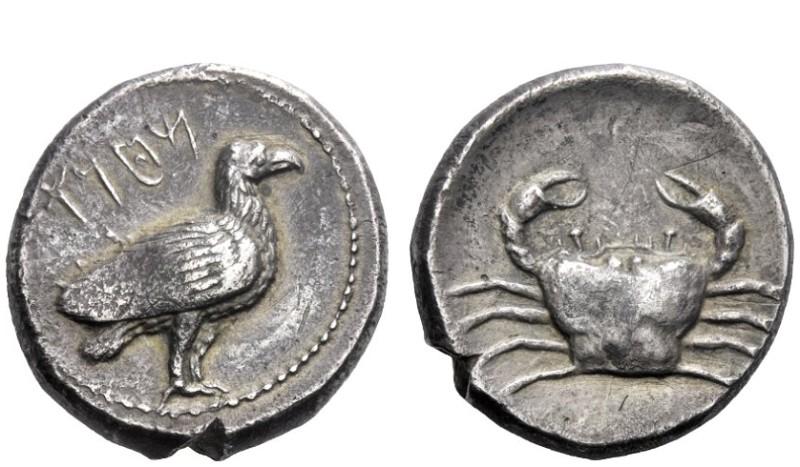Motya (Carthage), silver, tetradrachms (405-397 BCE)
From SILVER
(Redirected from AC 74 - Motya, silver, tetradrachms (405-397 BCE))
405 BCE - 397 BCE Silver 2,209 kg
Description
| ObverseInscription or printing placed on the obverse.: | (Punic).Eagle standing r. with folded wings, above, 'mtv' in Punic characters. |
| ReverseInscription or printing placed on the reverse.: | Crab seen from above |
Mint and issuing power
| MintIdentifies the place of manufacture or issue of a numismatic object.: | Motya | Ancient regionAncient region.: | Sicily | Modern countryModern country: Italy | AuthorityIdentifies the issuing power. The authority can be "pretended" when the name or the portrait of X is on the coin but he/she was not the issuing power. It can also be "uncertain" when there is no mention of X on the coin but he/she was the issuing power according to the historical sources: | Carthaginian Empire |
Chronology
| FromIdentifies the initial date in a range assigned in a numismatic context. | 405 BCE | toIdentifies the final date in a range assigned in a numismatic context.. | 397 BCE | PeriodTime period of the numismatic object.: Classical 480-323 BC |
Physical description
| MetalThe physical material (usually metal) from which an object is made.: | Silver |
Median weightMedian of the weights of numismatic objects (in grams). in grams | 17.10 | DenominationTerm indicating the value of a numismatic object. Examples: tetradrachm, chalkous, denarius.: | tetradrachm |
StandardStandard.: |
Image

AC 74 - Motya, silver, tetradrachms (405-397 BCE).jpg [1]
References
| Die study referencePublication of the study: | Jenkins 19711Jenkins 1971, n° 37-43 et 45-7. | ||
| Coin series referenceReference to coin series study: | Sear I2Sear I, n° 868-869, RQEMAC3RQEMAC, n° 74, HGC 24HGC 2, n° 921 | ||
| Coin series web referenceCoin series web references: | |||
Obverse dies distribution
| FrequencyFrequency of specimen in distribution. ᵖ | Number of obversesNumber of obverse dies. ᵖ (o) | % (o) | Number of coinsNumber of coins. (n) | % (n) | Die nameName(s) of the die(s). |
| 1 | 2 | 33.33 | 2 | 5.56 | 1, 4 |
| 4 | 1 | 16.67 | 4 | 11.11 | 5 |
| 5 | 1 | 16.67 | 5 | 13.89 | 3 |
| 6 | 1 | 16.67 | 6 | 16.67 | 2 |
| 19 | 1 | 16.67 | 19 | 52.78 | 6 |
| Total | 6 of 6 | 100.01 | 36 of 36 | 100.01 |
Reverse dies distribution
no distribution is available
Quantification
| Number of obversesNumber of obverse dies. ᵖ (o) | 6 | Number of singletons (o1)The number of singleton coins. ᵖ | 2 |
| Number of reverse diesNumber of reverse dies. (r) | 9 | Number of coinsNumber of coins. (n) | 36 |
| Coins per obverse dieNumber of coins per obverse die. (n/o) | 6 | Coins per reverse dieNumber of coins per reverse die. (n/r) | 4 |
| Reverse per obverse ratioRatio of obverse dies divided by reverse dies. (r/o) | 1.5 | Percentage of singletons (o1)number of coins (n) divided by the number of singletons (o1) ᵖ | 33.33 % |
| Original number of dies (O) (Carter 1983 formula)The estimation of the number of coins according to Carter 1983 ᵖ | 6.46 | Coins struck if 20,000 as average productivity per dieCoins made if the average productivity for obverses (according to Carter) is 20,000. ᵖ | 129,200 |
| Original number of dies (O) (Esty 2011 formula)The estimation of the number of coins according to the singleton formula in Esty 2011 ᵖ (O) | 7.2 | Survival rate if 20,000 as average productivity per dieSurvival rate if average productivity is 20,000. ᵖ | 0.00028 |
| Coverage (o = % of O) (Esty 1984 formula)Esty 1984 - coverage (% of O) ᵖ (o = % of O) | 94.44% | Die productivity if survival rate 1/2,000Average productivity if survival rate is 1/2,000. ᵖ | 11,145.51 |
| Weight of silver (in kg) if 20,000 coins per die (O = Carter formula)Carter 1983 * Median weight * 20000 (*10 if gold or electrum) ᵖ | 2,209 kg <br /> 2,209 kg | Die productivity if survival rate 1/5,000Average productivity if survival rate is 1/5,000. ᵖ | 27,863.78 |
Remarks
Most likely one single workstation